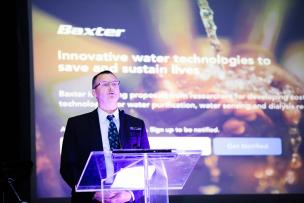How We Did It...
From crowdfunding to collaboration: The Story Behind Halo
January 13th, 2020
Today, Halo is a marketplace that helps connect academic scientists with industry for sponsored research, but that’s not how it started. Read on to learn how we went from crowdfunding to collaboration and landed our first industry partnership with Baxter.
In 2018 Halo launched as a crowdfunding platform for academic research to help advance promising academic discoveries across the so-called “valley of death,” It was through that experience that we learned about one of the other major obstacles preventing more academic innovations from becoming market realities - the academic/industry divide.
As you well know, that “divide” takes a variety of forms.
For one, geographic barriers make it logistically challenging for companies clustered in major metros to meet academic scientists who are predominantly scattered across the country. Industry jargon and acronyms don't help either and can make it challenging for academic scientists to understand what companies are truly seeking.
Despite the undeniable social and economic benefits that come from academic/industry collaboration, these barriers prevent so much of that value from being fully realized.
Design thinking and lean startup methodology
No one understands this divide better than those working in corporate relations at a university, of course. A far greater challenge is coming up with a solution that even begins to solve one or more of the underlying barriers. To start thinking about a solution, we borrowed tactics from design thinking and lean startup methodology.
First, we conducted dozens of in-depth customer discovery interviews with academic scientists, university officials and industry partners. Our goal was to understand the needs of each and develop empathy for their situation, a hallmark of design thinking. To accomplish this, we kept our questions open-ended and followed each with “Why” to get closer to the unvarnished truth.
Second, we gathered insights from these conversations and brainstormed how they might translate to the functionality and interface of the website itself. We prototyped low-fidelity, interactive wireframes with tools like Sketch, Invision and Figma.
Third, we user-tested the prototypes with each audience, and asked them to accomplish a simple task, like creating an account, while speaking their thoughts. One of those user testers was an executive in external innovation at Baxter. When she started interacting with the prototype, she instantly saw how it could help Baxter.
How might we turn tap water into dialysis solution
Baxter invests $650 million annually in R&D and home dialysis is one of its largest product segments. Like all forms of dialysis, home dialysis requires a special solution made from “ultra pure water” formulated in factories, packaged in IV bags and shipped in boxes to patients around the world. The average home dialysis patient receives 900 pounds (not a typo) of this solution every month. Baxter was interested in exploring how tap water might be turned into dialysis solution to relieve patients of this burden.
After seeing the prototype, the executive at Baxter saw how Halo could be used to reach scientists studying water in regions unexplored or where it simply lacked established relationships. While Halo’s original plan was to begin by focusing on a therapeutic area, like neuroscience or oncology, nothing impacts human health, industry and the world which we live more than water. Turns out scientists who study water are a cross-disciplinary bunch and include environmental engineers, chemical engineers, chemists, synthetic biologists and electrical engineers.
Working with the Baxter executive and her team, we developed a plan to build out a network of water researchers on Halo and announced the partnership at the 2019 Halo Awards. Since the program went live less than a month ago, more than a hundred academic scientists and universities have created accounts, from UCLA to University of Florida and everywhere in between, from lesser-known rural institutions to large state-funded universities to the Ivy League.
All NACRO members are encouraged to create their own university accounts on Halo to stay up-to-date for when new industry opportunities post. While the current focus is Water Research, we will be adding new research areas soon. If you have any feedback or questions at all about Halo or our program with Baxter, don’t hesitate to reach out to Kevin Leland at [email protected].
|